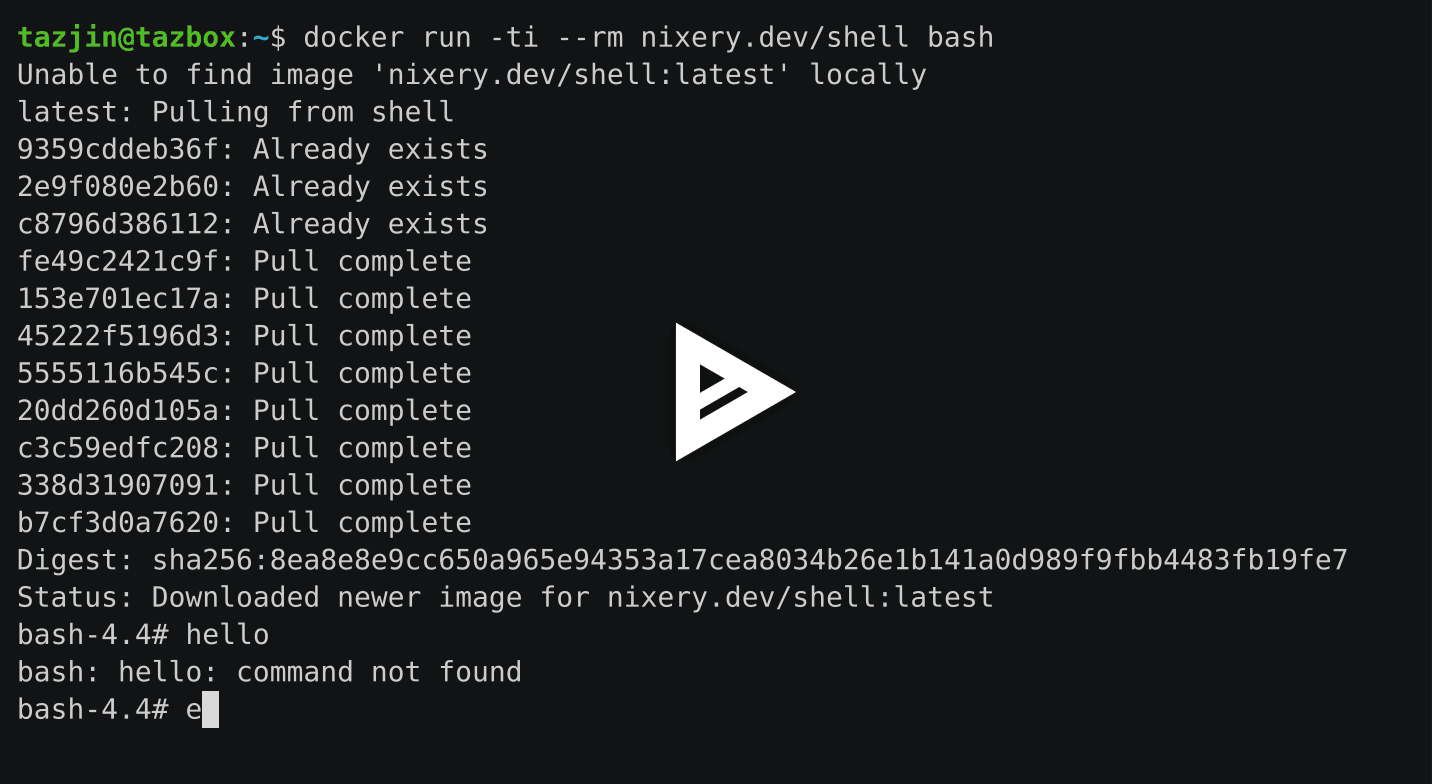Nixery is a Docker-compatible container registry that is capable of transparently building and serving container images using Nix.
Images are built on-demand based on the image name. Every package that the user intends to include in the image is specified as a path component of the image name.
The path components refer to top-level keys in nixpkgs and are used to build a
container image using a layering strategy that optimises for caching popular
and/or large dependencies.
A public instance as well as additional documentation is available at nixery.dev.
You can watch the NixCon 2019 talk about Nixery for more information about the project and its use-cases.
The canonical location of the Nixery source code is
//tools/nixery in the TVL
monorepository. If cloning the entire repository is not desirable, the
Nixery subtree can be cloned like this:
git clone https://code.tvl.fyi/depot.git:/tools/nixery.git
The subtree is infrequently mirrored to tazjin/nixery on Github.
Demo
Click the image to see an example in which an image containing an interactive
shell and GNU hello is downloaded.
To try it yourself, head to nixery.dev!
The special meta-package shell provides an image base with many core
components (such as bash and coreutils) that users commonly expect in
interactive images.
Feature overview
-
Serve container images on-demand using image names as content specifications
Specify package names as path components and Nixery will create images, using the most efficient caching strategy it can to share data between different images.
-
Use private package sets from various sources
In addition to building images from the publicly available Nix/NixOS channels, a private Nixery instance can be configured to serve images built from a package set hosted in a custom git repository or filesystem path.
When using this feature with custom git repositories, Nixery will forward the specified image tags as git references.
For example, if a company used a custom repository overlaying their packages on the Nix package set, images could be built from a git tag
release-v2:docker pull nixery.thecompany.website/custom-service:release-v2 -
Efficient serving of image layers from Google Cloud Storage
After building an image, Nixery stores all of its layers in a GCS bucket and forwards requests to retrieve layers to the bucket. This enables efficient serving of layers, as well as sharing of image layers between redundant instances.
Configuration
Nixery supports the following configuration options, provided via environment variables:
-
PORT: HTTP port on which Nixery should listen -
NIXERY_CHANNEL: The name of a Nix/NixOS channel to use for building -
NIXERY_PKGS_REPO: URL of a git repository containing a package set (uses locally configured SSH/git credentials) -
NIXERY_PKGS_PATH: A local filesystem path containing a Nix package set to use for building -
NIXERY_STORAGE_BACKEND: The type of backend storage to use, currently supported values aregcs(Google Cloud Storage) andfilesystem.For each of these additional backend configuration is necessary, see the storage section for details.
-
NIX_TIMEOUT: Number of seconds that any Nix builder is allowed to run (defaults to 60) -
NIX_POPULARITY_URL: URL to a file containing popularity data for the package set (seepopcount/)
If the GOOGLE_APPLICATION_CREDENTIALS environment variable is set to a service
account key, Nixery will also use this key to create [signed URLs][] for layers
in the storage bucket. This makes it possible to serve layers from a bucket
without having to make them publicly available.
In case the GOOGLE_APPLICATION_CREDENTIALS environment variable is not set, a
redirect to storage.googleapis.com is issued, which means the underlying bucket
objects need to be publicly accessible.
Storage
Nixery supports multiple different storage backends in which its build cache and image layers are kept, and from which they are served.
Currently the available storage backends are Google Cloud Storage and the local file system.
In the GCS case, images are served by redirecting clients to the storage bucket. Layers stored on the filesystem are served straight from the local disk.
These extra configuration variables must be set to configure storage backends:
GCS_BUCKET: Name of the Google Cloud Storage bucket to use (required forgcs)GOOGLE_APPLICATION_CREDENTIALS: Path to a GCP service account JSON key (optional forgcs)STORAGE_PATH: Path to a folder in which to store and from which to serve data (required forfilesystem)
Background
The project started out inspired by the buildLayeredImage blog post with the intention of becoming a Kubernetes controller that can serve declarative image specifications specified in CRDs as container images. The design for this was outlined in a public gist.
Roadmap
Kubernetes integration
It should be trivial to deploy Nixery inside of a Kubernetes cluster with correct caching behaviour, addressing and so on.
See issue #4.
Nix-native builder
The image building and layering functionality of Nixery will be extracted into a separate Nix function, which will make it possible to build images directly in Nix builds.
编辑推荐精选


TRAE编程
AI辅助编程,代码自动修复
Trae是一种自适应的集成开发环境(IDE),通过自动化和多元协作改变开发流程。利用Trae,团队能够更快速、精确地编写和部署代码,从而提高编程效率和项目交付速度。Trae具备上下文感知和代码自动完成功能,是提升开发效率的理想工具。


博思AIPPT
AI一键生成PPT,就用博思AIPPT!
博思AIPPT,新一代的AI生成PPT平台,支持智能生成PPT、AI美化PPT、文本&链接生成PPT、导入Word/PDF/Markdown文档生成PPT等,内置海量精美PPT模板,涵盖商务、教育、科技等不同风格,同时针对每个页面提供多种版式,一键自适应切换,完美适配各种办公场景。


潮际好麦
AI赋能电商视觉革命,一站式智能商拍平台
潮际好麦深耕服装行业,是国内AI试衣效果最好的软件。使用先进AIGC能力为电商卖家批量提供优质的、低成本的商拍图。合作品牌有Shein、Lazada、安踏、百丽等65个国内外头部品牌,以及国内10万+淘宝、天猫、京东等主流平台的品牌商家,为卖家节省将近85%的出图成本,提升约3倍出图效率,让品牌能够快速上架。


iTerms
企业专属的AI法律顾问
iTerms是法大大集团旗下法律子品牌,基于最先进的大语言模型(LLM)、专业的法律知识库和强大的智能体架构,帮助企业扫清合规障碍,筑牢风控防线,成为您企业专属的AI法律顾问。


SimilarWeb流量提升
稳定高�效的流量提升解决方案,助力品牌曝光
稳定高效的流量提升解决方案,助力品牌曝光


Sora2视频免费生成
最新版Sora2模型免费使用,一键生成无水印视频
最新版Sora2模型免费使用,一键生成无水印视频


Transly
实时语音翻译/同声传译工具
Transly是一个多场景的AI大语言模型驱动的同声传译、专业翻译助手,它拥有超精准的音频识别翻译能力,几乎零延迟的使用体验和支持多国语言可以让你带它走遍全球,无论你是留学生、商务人士、韩剧美剧爱好者,还是出国游玩、多国会议、跨国追星等等,都可以满足你所有需要同传的场景需求,线上线下通用,扫除语言障碍,让全世界的语言交流不再有国界。


讯飞绘文
选题、配图、成文,一站式创作,让内容运营更高效
讯飞绘文,一个AI集成平台,支持写作、选题、配图、排版和发布。高效生成适用于各类媒体的定制内容,加速品牌传播,提升内容营销效果。


商汤小浣熊
最强AI数据分析助手
小浣熊家族Raccoon,您的AI智能助手,致力于通过先进的人工智能技术,为用户提供高效、便捷的智能服务。无论是日常咨询还是专业问题解答,小浣熊都能以快速、准确的响应满足您的需求,让您的生活更加智能便捷。


imini AI
像人一样思考的AI智能体
imini 是一款超级AI智能体,能根据人类指令,自主思考、自主完成、并�且交付结果的AI智能体。
推荐工具精选
AI云服务特惠
懂AI专属折扣关注微信公众号
最新AI工具、AI资讯
独家AI资源、AI项目落地

微信扫一扫关注公众号





